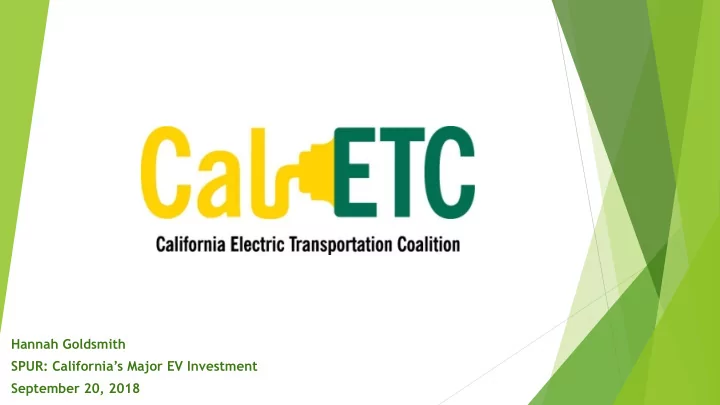

Hannah Goldsmith SPUR: California’s Major EV Investment September 20, 2018
About CalETC u CalETC supports and advocates for the transition to a zero-emission transportation future as a means to spur economic growth, fuel diversity and energy independence, achieve clean air, and combat climate change. u Board and Associate Members:
EV Policy Landscape u Incentives u Regulations u Utility Investment u Our biggest priorities
EV Policy Landscape in California: Incentives u CEC Alternative and Renewable Fuel and Vehicle Technology Program. Created by the California Alternative and Renewable Fuel, Vehicle Technology, Clean Air, and Carbon Reduction Act of 2007 (AB 118) and authorizes the Energy Commission to develop and deploy alternative and renewable fuels and advanced transportation technologies to help attain the state's climate change policies. Funds the build out of EV charging and hydrogen infrastructure and the advancement of cleaner light-, medium-, and heavy-duty vehicle technology. u CARB Air Quality Improvement Program. Also created by AB 118 (2007), is an incentive program administered by CARB to fund clean vehicle and equipment projects, research of biofuels production. u CARB Low Carbon Transportation Investments, funded by Cap & Trade Auction Proceeds, and must be used to further the purposes of Assembly Bill 32 (2006)—reduce greenhouse- gas emissions. Funds CVRP , HVIP , EFMP Plus Up, advanced technology demonstrations, and other programs. u Non-monetary incentives are also critical. E.g., HOV-lane access for ZEVs and free or reduced parking/charging.
EV Policy Landscape in California: Regulations ZEV Regulation: first adopted in 1990 and has been modified multiple times since; u currently requires manufacturers to produce a number of ZEVs and plug-in hybrids each year, based on the total number of cars sold by the manufacturer in CA. Requirements are in terms of percent credits, ranging from 4.5% in 2018 to 22% by 2025. Low Carbon Fuel Standard: The goal of the LCFS is to reduce the carbon intensity u of the transportation fuels mix 10% by 2020. CARB is in the process of amending the regulation to further strengthen the CI reduction through 2030 to: 20% reduction in fuel CI from a 2010 baseline by 2030, among other amendments. The LCFS serves as another incentive for transportation electrification. CALGreen: The California Green Building Code includes both mandatory and u voluntary “reach code” measures that cities can adopt. For EV charging readiness, the code requires raceway and panel capacity at specified percentages for residential and non-residential new construction. There are open proceedings proposing to extend EV charging readiness measures to schools and community colleges and to increase the required amount of EV readiness for multi-unit dwellings.
EV Policy Landscape in CA: Utility Investment The CPUC lifted its ban on utility investment in transportation electrification at the end of 2014. u Following this decision, the three large investor-owned utilities proposed investments in light- u duty charging pilot programs targeting workplaces, multi-unit dwellings, and long-dwell time destination centers. Implementation of these pilots began in 2016; $197 million investment; 12,500 primarily L2 charging ports. SB 350, the Clean Energy and Pollution Reduction Act, was signed into law in October 2015, u establishing new clean energy, clean air and greenhouse gas reduction goals for 2030 and beyond. SB 350 requires the CPUC to direct electrical corporations to file applications for programs and investments to accelerate widespread transportation electrification. AB 1082 and 1083 (2017) encourage the IOUs to propose pilot programs for EV charging u infrastructure at schools, state parks, and state beaches. We anticipate the CPUC will issue a decision on IOU proposals by December 2018. Publicly-owned utilities are also investing in transportation electrification. u
CalETC’s biggest priorities u Accelerating the ZEV market and charging-station deployment u Incentives for vehicles and fueling infrastructure u Low Carbon Fuel Standard u Innovative Clean Transit u Electricity Rates & Strategies
Thank you! Hannah Goldsmith hannah@caletc.com Visit us at caletc.com
ZEV Fueling Infrastructure Existing public charging plugs: 17,327 u Governor’s goal: 250,000 including 10,000 DCFC by 2025 u Existing hydrogen stations: 35 u Governor’s goal: 200 by 2025 u We must leverage public and private funds to get there. CalETC u conservatively estimates the amount of funding needed for light-duty public charging infrastructure is about $2.2 billion beyond known public and private investments. That number grows as we add medium- and heavy-duty charging, and hydrogen stations.
Recommend
More recommend